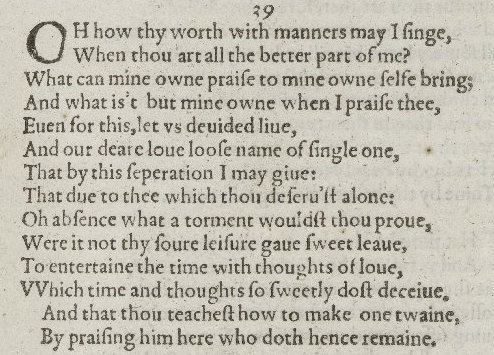O, how thy worth with manners may I sing,When thou art all the better part of me?What can mine own praise to mine own self bring?And what is’t but mine own when I praise thee?Even for this let us divided live,And our dear love lose name of single one,That by this separation I may giveThat due to thee which thou deserv’st alone.O absence, what a torment wouldst thou prove,Were it not thy sour leisure gave sweet leaveTo entertain the time with thoughts of love,Which time and thoughts so sweetly doth deceive,And that thou teachest how to make one twain,By praising him here who doth hence remain! 481214 | ||
 | ||
Q1Q2Q3C O, how thy worth with manners may I sing,When thou art all the better part of me?What can mine own praise to mine own self bring?And what is’t but mine own when I praise thee?Even for this let us divided live,And our dear love lose name of single one,That by this separation I may giveThat due to thee which thou deserv’st alone.O absence, what a torment wouldst thou prove,Were it not thy sour leisure gave sweet leaveTo entertain the time with thoughts of love,Which time and thoughts so sweetly doth deceive,And that thou teachest how to make one twain,By praising him here who doth hence remain! | ||
Sonnet 39 is one of 154 sonnets written by the English playwright and poet William Shakespeare. It is a member of the Fair Youth sequence, in which the poet expresses his love towards a young man.
Contents
Structure
Sonnet 39 is a typical English or Shakespearean sonnet, constructed from three quatrains and a final rhyming couplet for a total of fourteen lines. It follows the form's rhyme scheme, abab cdcd efef gg. Like other Shakespearean sonnets it is written in iambic pentameter, a type of poetic metre based on five pairs of metrically weak/strong syllabic positions. The second line exemplifies a regular iambic pentameter:
× / × / × / × / × / When thou art all the better part of me? (39.2)/ = ictus, a metrically strong syllabic position. × = nonictus.The fifth line can be scanned with both an initial and medial reversal:
/ × × / / × × / × / Even for this, let us divided live, (39.5)Themes
Sonnet 39 is about the necessity of separation. The last few lines could cause some confusion; the poet is saying that, although he is separated from his lover, and therefore 'twain' or divided, they are really still the same. This can be so because of the sweet thought of love guiding the poet, allowing him to show that his lover is still within his heart and thus joined to him in spirit, no matter where his lover is in body. No one knows for sure the true identity of Shakespeare's dear friend, but most scholars agree that he was the Earl of Southampton, the poet's patron.
